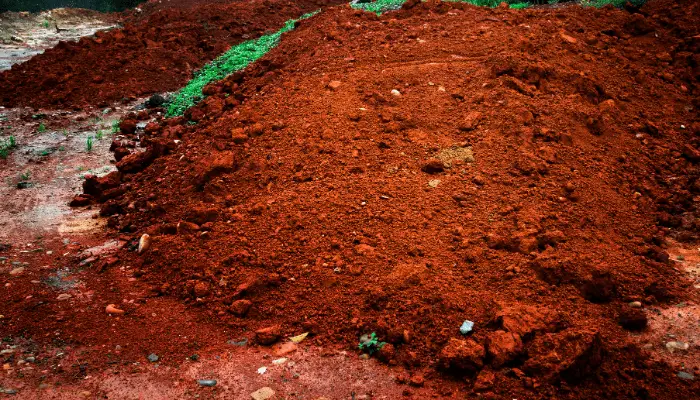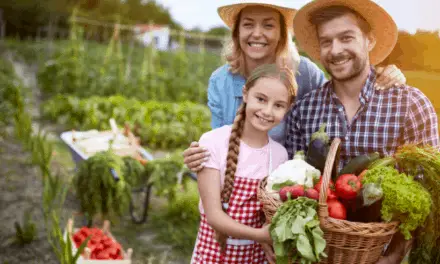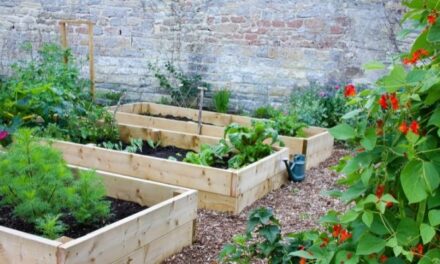Red clay soil is naturally nutrient-rich and great for growing vegetables as long as you don’t overwater or underwater it and mix lots of organic matter like aged bark and composted leaves into it so that the soil is not too sandy or too tightly packed for vegetables to grow.
When deciding to start a vegetable garden or even when you already have an established garden, knowing the type of soil you’re working with is vital for getting the most out of your vegetable crop.
In this guide, we’ll be taking a closer look at red clay soil, its pros, cons, and how you can get the most out of it.
Table of Contents
What Is Red Clay Soil?

All soils are made up of varying amounts of sand, silt, and clay particles.
Red clay soil is predominantly made up of clay and its red color comes from the presence of iron oxide (rust) in the soil.
Unlike more sandy types of soil, red clay soil is naturally full of nutrients and has the capacity to attract and adsorb elements like potassium, ammonium, calcium, and magnesium, which makes it very good for growing vegetables.
The Problems With Growing Vegetables In Red Clay Soil
Many people who live around clay speak poorly of it strictly because of how messy it is.
But if you plan to grow vegetables in it, there’s more to worry about than the mess you’ll make.
Related Article: Is Red Clay Soil Good For Plants?
It’s Fine And Tightly Packed
The problem with growing vegetables in this type of soil is that it’s often very fine and tightly compressed.
And this can limit the amount of oxygen and nutrients your vegetables are receiving from the soil because it’s too tightly packed around the roots.
It Has Poor Drainage
Red clay soil can also become waterlogged more easily than other types of sandier soil.
Soils that are rich in clay hold on to water and don’t allow it to drain away.
Some vegetables like watercress can actually thrive in waterlogged soil.
But working in waterlogged clay is not what you are going to want for your home garden.
Waterlogging issues can be alleviated over time by adding organic material to the clay soil and making it less compact.
Clay also tend to be acidic and lower in calcium than other types of soil.
Some gardeners choose to add lime to raise the pH of red clay soil and add some of its missing minerals.
How To Improve Red Clay Soil For Growing Vegetables
Very compacted clay may not be ideal for growing vegetables at first because it may be too fine and dense.
And this can actually starve vegetables of oxygen and nutrients.
But not to worry, there are a few things you can do to drastically improve the quality of clay soil for vegetable growing.
Add Organic Matter
Probably the number one thing you want to be doing with compacted clay soil is adding organic matter to it as often as you can.
Organic matter will make the soil less dense and improve aeration, levels of nutrients, and drainage.
Usually, you can drastically improve red clay soils for growing vegetables by mixing in organic materials.
Materials like bark, sawdust, manure, compost, and peat moss work well to improve the texture of tightly packed red soil.
Add Garden Lime
Another way to improve the texture of clay soils is to add lime to them.
This will raise the pH level and make the soil more alkaline and less clumpy.
This encourages larger soil particles which will improve drainage and make it less compact and easier to work with.
Do Not Overwater
Clay gets waterlogged easily.
Water it sparingly at first and watch out for any areas that are remaining wet – these always-wet areas are an indication that you’re overwatering the ground and need to cut back.
Keep Off The Soil
Walking on clay soil can compact it even further and make it more difficult to grow vegetables in.
Arrange permanent raised beds for growing your vegetables and keep paw prints and footprint off the soil.
Don’t Work Red Clay Soil When It’s Wet
You’ll create a huge mess and won’t accomplish much trying to work with this soil when it’s wet so just give it time and allow it to dry.
You might want to protect the soil from rain by covering it with mulch or a piece of plastic fabric.
Level The Soil
To avoid destroying the structure of clay soil it is important to keep raking to a minimum.
Excessive raking is likely to bring soggy lumps of clay to the surface and make it difficult to create a seedbed.
By leveling the soil you will drastically reduce the amount of raking you’ll have to do later.
This will help to maintain the structure of the soil and create a much healthier environment for the seeds to grow in.
Observe And Keep An Eye On Things
Are there vegetables or plants already growing in the soil?
If there are and they look vibrant and healthy then you’re probably doing just fine.
On the other hand, if leaves are looking a bit yellow and plants are a bit limp, there are issues that will need to be addressed.
Should You Add Grit, Sand, Or Gravel To Red Clay Soil
Clay particles are extremely dominant in soil because they are tiny and can easily fill up space.
Sand and silt particles are bigger, so it takes fewer particles to fill a space.
This makes the surface area of clay much more influential in determining the overall texture of the soil.
In reality, you would need to add massive amounts of gravel to change the packed texture of red clay soil, and this is usually not a feasible option.
Even if a clay soil is not too dense and contains less than 50 percent clay particles, you would need to add a huge amount of gravel to make the soil easier to work.
Adding too much gravel to clay can also make it unstable and more difficult to manage.
It’s best to stick to the other tips in this article but if you really want to try it out adding sand, grit or gravel to your soil, test it out on a small scale at first.
The Best Vegetables For Red Clay Soil
Lettuce, green beans, chard, and other vegetables with shallow roots do better in red soil because of its ability to retain water.
Other vegetables like broccoli, Brussels sprouts, and cabbage also grow well in red clay soil because their roots can anchor better within the fine soil.
Vegetables that grow quickly can help improve the soil by extracting water from it.
And deep and medium-rooted vegetables, such as sweet potatoes, watermelons, and kale can further help to improve the soil quality.
Good cultivation and the addition of nitrogen fertilizers will promote plant growth, help with drainage, and Improve soil structure.
When harvesting vegetables, give the ground a dig and bury any weeds or organic material while leaving the ground as level as possible.
When working the soil, try to leave behind lumps about the size of tennis balls – so they are not too big to break up next time you come back and not so small that they completely fall apart in winter.
Conclusion
Red clay soil can be challenging and will probably need some love and special attention before you start seeing results.
But once you work to enhance it, red clay soil can be a rich growing medium that retains moisture and nutrients and creates almost perfect growing conditions for vegetables.




